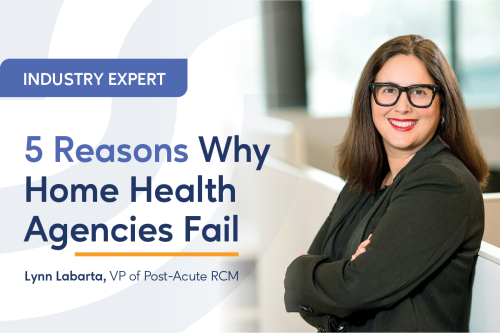Struggling with cash flow and keeping your home health agency doors open? You are not alone. Industry veteran Lynn Labarta, VP of Post-Acute RCM at SimiTree, reveals five critical factors that could jeopardize your agency's financial viability. If you’re not up for the quick read, watch Lynn’s video now explaining each issue and a quick solution.
Staying ahead of these potential pitfalls is crucial for success in the fiercely competitive home health and hospice industry. By proactively addressing challenges and adapting your strategies, you can boost your agency's financial health and ensure long-term sustainability.
Let’s discuss the 5 most common reasons agencies struggle:
5 Common Pitfalls Leading to Home Health Agency Failure and Our Solutions
-
Not Keeping Track of the “Unbilled” Claims Lists:
This critical report, often titled "unsubmitted," "pending QA," or "unbilled claims," exposes claims awaiting submission due to incomplete clinical tasks (face-to-face encounters, missing care plans, etc.). Agencies facing financial strain often neglect this report, overlooking potentially sizable sums of revenue trapped in administrative purgatory.
Agencies that are at risk of cash flow issues tend not to review this report and therefore are unaware of the possible high dollar amounts unable to be billed. These are actions that need to be taken by the office staff or clinicians to get that claim billed.
Our recommendation: Leaders and managers should conduct daily reviews of this report, holding staff accountable for promptly resolving pending tasks to ensure timely claim submission and improved cash flow.
-
Incorrect Primary Payer Selection:
Selecting the correct payer at intake is paramount. Choosing the wrong one guarantees claim rejection and lost revenue. This could be a clerical error, but often highlights the need for enhanced staff training on patient insurance verification.
Our recommendation: SimiTree suggests assigning payer selection in your EMR to an individual with proficiency in eligibility verification. Additionally, provide regular staff training on eligibility processes and their impact on agency cash flow.
-
Misunderstand Payer Reimbursement Processing Times:
Different payers pay out claims at different times. You need to know those time frames! Not clearly understanding when claims payout will make it exceedingly difficult to manage your agencies’ expenses. For example, HHA Medicare claims typically pay within 14-30 days after the claim is billed. However, if the claim gets rejected then your payment time frame could be doubled.
Our recommendation: Review your insurance company contracts and create a chart outlining each payer’s reimbursement timeframe. This will make it easier to track if there are any claims issues and allow you to intervene quickly.
-
Enrollment/Contracting Challenges with Commercial Insurers:
Contracting issues with commercial insurance companies such as UHC, BCBS, etc. are common. These enrollment issues can delay your payments significantly. Here are some examples of these problems: the claims department at an insurance company does not have a 1099 tax form on file, your NPI is not on file with the payer, you are not contracted with that plan, etc. The list goes on!
Our recommendation: Consider partnering with a home health-specialized billing service to process your claims. This level of expertise will minimize these types of rejections since your billing representatives can contact the payers on your behalf to resolve these issues.
-
Authorizations Lapses:
Most commercial insurance companies require prior authorizations for all disciplines providing services to a patient. Most agencies know this…where we see the challenge is that some agencies exceed their authorizations. The bottom line is, that if you do not have authorization, you will not be paid for that visit. So, tracking this is crucial to avoid revenue loss.
Our recommendation: Implement a system that leverages your software's authorization reports to trigger weekly alerts for expiring authorizations. This allows time to secure additional authorizations or reschedule affected visits to avoid revenue loss and maintain financial stability.
-
- Addressing these challenges requires a strategic approach:
- Proactive financial management
- Optimized operational processes
- Adaptability in the dynamic healthcare landscape
How SimiTree Can Help
If you haven’t watched Lynn’s message now, don’t miss it! If you want to address these challenges with an expert in your field, this is where SimiTree comes in. We partner with home health and hospice agencies to secure their financial sustainability by tackling these very issues. Let us help you:
-
- Reduce claim processing delays and optimize cash flow.
- Minimize claim rejections and maximize revenue recovery.
- Improve operational efficiency and reduce administrative burdens.
- Stay compliant with ever-changing regulations.
Don't let financial roadblocks hinder your agency's success. Let SimiTree be your partner in navigating the path to financial stability and growth. Learn more about SimiTree revenue cycle management and home health billing.
Discover Related Topics:
Explore a variety of topics related to healthcare revenue management, revenue cycles, and billing efficiency for a well-rounded perspective.
Tips for Streamlining Your Insurance Billing Process
EMRs vs. EHRs FAQ: Exploring Digital Solutions in Home Health and Hospice
How Can a Revenue Cycle Management Assessment Benefit Your Behavioral Health Organization?
The Hospice Billing Playbook: A Step-by-Step Guide to Success
Avoid the #1 Claim Rejection: Patient Eligibility

